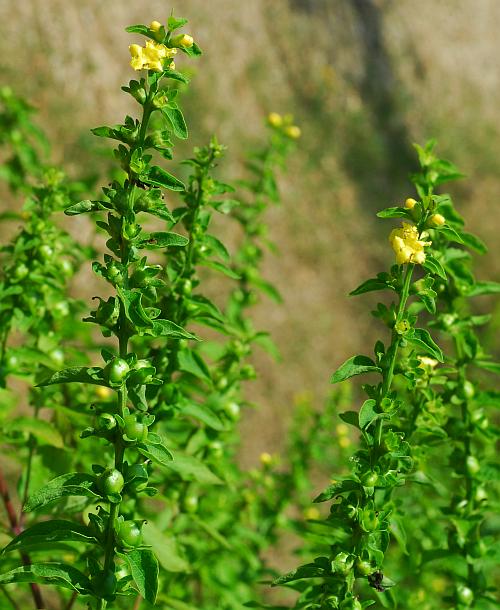Dasistoma macrophyllum (Nutt.) Raf.
Mullein Foxglove

Native
CC = 5
CW = 3
MOC = 47
© SRTurner
Dasistoma macrophyllum (Nutt.) Raf.Mullein Foxglove | |
 |
Native CC = 5 CW = 3 MOC = 47 |
© SRTurner |
|
Family - Orobanchaceae Habit - Annual, hemiparasitic forb. Stems - Strongly ascending to erect, to 2.2 m, usually with many branches, mostly bluntly 4-angled, moderately to densely pubescent with fine, curved, nonglandular hairs, sometimes only on 2 opposing sides.
Leaves - Opposite, sessile or short-petiolate, the petioles winged, at least toward the tip. Blades 10-35 cm long, lanceolate to broadly ovate in outline, those of the lower leaves moderately to deeply 1 or 2 times pinnately lobed or divided, the margins also toothed, those of the upper leaves often only shallowly lobed or toothed, the surfaces sparsely to moderately pubescent with short, slightly broad-based, nonglandular hairs, mostly along the veins. Foliage typically dark green, sometimes purplish-tinged.
Inflorescence - Terminal spikelike, racemes on the main stems and branches. Flowers subtended by leafy bracts, these reduced toward the branch tip, entire or few-lobed. Pedicels 1-4 mm long, stout, thickened toward the tip, hairy, lacking bractlets. Inflorescence appearing as just paired axillary flowers because of the foliaceous bracts.
Flowers - Calyces 6-8 mm long, becoming elongated to 7-10 mm at fruiting, 5-lobed, slightly zygomorphic, bell-shaped, the tube moderately short-hairy on the outer surface, densely and minutely hairy on the inner surface, the lobes about as long as to longer than the tube at flowering, longer than the tube at fruiting, entire or with 1 or 2 blunt teeth, the surfaces glabrous or sparsely short-hairy, the margins hairy in the sinuses between the lobes. Corollas 14-16 mm long, 5-lobed, weakly zygomorphic and bilabiate, yellow, the tube densely hairy on the inner surface, the beard tending to partially block the throat, the lobes shorter than the tube, more or less spreading, 1 of the lobes often arched upward, the surfaces glabrous, the margins glabrous or minutely hairy. Stamens with the filaments of 2 lengths, hairy, the anthers with 2 sacs, these more or less parallel, tapered to a minute, awnlike base, light yellow to yellow, glabrous. Style relatively short and stout, not exserted, the stigma more or less capitate, 2-lobed.
Fruits - Globose capsules, 6-11 mm diameter, slightly flattened, glabrous. Dehiscent longitudinally from tip. Seeds 2.0-2.5 mm long, irregularly oblong-ellipsoid to more or less trapezoid, usually slightly flattened, the surface with a coarse network of often fine ridges and pits, the ridges sometimes appearing winglike, brown to dark brown or black. Empty capsules often persist on dried stems well into following season.
Flowering - June - September. Habitat - Bottomland and mesic forests, streambanks, ravines, bluff bases, glades. Origin - Native to the U.S. Lookalikes - Some resemblance to species of the closely related genus Aureolaria. Other info. - This species occurs across much of Missouri, in somewhat scattered form and most commonly south of the Missouri River. Beyond Missouri its natural range extends throughout much of the U.S. Midwest. The plant is recognized by its generally large and erect stature, dark green foliage, pinnatifid lower leaves, and smallish yellow flowers. The flowers are tubular, zygomorphic, and 5-lobed. Plants are very commonly affected by a microbial infection which causes black patches on the leaves and flowers. Photographs taken at the Springfield Nature Center, Springfield, MO., 7-5-03, and at Pultite Spring, Shannon County, MO., 7-23-04 (DETenaglia); also at Onondaga Cave State Park, Crawford County, MO, 7-31-2014, Shaw Nature Reserve, Franklin County, MO, 8-20-2017, Glassberg Conservation Area, Jefferson County, MO, 8-5-2020, and Niangua Natural Area, Dallas County, MO, 4-22-2023 (SRTurner). |